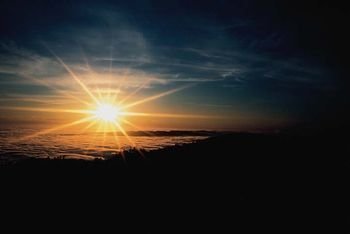
This, the week leading up to the Winter Solstice on December 21 is the darkest time of the year. True, the week following the solstice is just as dark, but the energy is different. After the solstice, the dark gets a tiny bit lighter each day as we in the Northern Hemisphere inch toward spring. But now, pre-solstice, we are spinning further and further into the darkest of the dark.
The Winter Solstice is as dark as it gets. The sun has been steadily retreating ever since the Summer Solstice, the height of the light. Tip toeing slowly, silently away, minute by minute every day. The decrease, so gradual that we barely notice the almost imperceptible shift, the subtle loss, until there is no longer denying it. It is most definitely darker, and darker still.
The rays of light have become ever more indirect. They skim by overhead at an almost horizontal angle, their energy and warmth barely reaching us below. Their glow is weak and wan, a diluted wash. Leaving us standing here in the dark. Waiting. Hoping.
It's dark. It's dismal. It's cold. It's bleak. And winter is only just about to begin. It will be long months before we can expect to smell the advance of spring in the air again. But the consolation is that even though the cold dark season is just starting, the sun will soon turn its face toward us and begin its return approach. And the light will return in its wake, increasing slowly but constantly in minute, and oh so welcome, increments.
But in the meantime it's damn dark out there. Dim and drab. The days have shriveled to a skeleton flicker of light. The frozen nights are endless. No flowers, no foliage. No insects, not many birds. Few animals out and about. Life is dormant. The earth itself is congealed with cold. Dark death and Arctic gloom surrounds us. How do we know that the sun, too, won't die, its flame of life extinguished forever? How do we know that it won't just go off and leave us forever, abandon us to the long frigid night?
Wrapped in the dark womb of the weather, it is not difficult to imagine the terrifying prospect of the permanent demise of the sun and the consequent loss of light, loss of heat. The loss of all life. Without the comfort of the familiar, dependable, predictable cyclical patterns of the cosmos, the approach of each winter with its attendant chiaroscuro would be agonizing. The tension intensified by the chill.
We know the sun will return, because it always has. And because we have, to the best of our abilities, computed that it always will (at least for the next x billion years). We can see the seasonal cycle of light and dark through the scope of thousands of years of the accumulated astronomical data -- observations, investigations, calculations and collective experience -- of many cultures. We know with fair certainty that light follows dark, day follows night, spring follows winter. We are quite confident, secure in the sure return of the faithful sun. We haven't the slightest conscious doubt.
We know that the sun and the earth travel ever together, turning, circling, spinning through space. The earth and the sun, are eternally engaged in a cosmic back-and-forth-give-and-take dosey-do dance of dark and light, day and night. A teasing lovers' tango of tantalizing seduction and rude rejection. A veritable cha-cha-cha of flirtatious come-hithers and disdainful be-gones. Of beat retreat and eventual return. An again and again samba for all seasons. An eternal waltz played in annual time.
Though my soul may set in darkness,
It will rise in perfect light,
I have loved the stars too fondly
To be fearful of the night.
- Sarah Williams